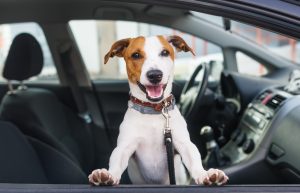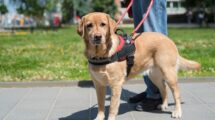Animal Chatter
By Iris Winston
Make your pet’s comfort a priority when travelling

Perhaps despite all the issues with COVID-19,you are thinking about taking a trip with your pet. You will, of course, take all the precautions associated with the virus, as a prelude to giving your furry companion a happy and safe time.
Family trips are more fun if the furry family member is with you. Certainly, that goes for dogs, though most cats prefer to be cared for in their home territory, while the family is away.
But, travelling with pets, whether on a long-distance vacation by plane or automobile or simply taking a local outing, requires just as much forethought and care as travelling
with a small child.
Do you remember what happened when U.S. presidential hopeful Mitt Romney took his Irish Setter, Seamus, on vacation? During the family’s 1,000 kilometre trip from their Massachusetts home to Canada, Seamus rode for 12 hours in a hard-sided dog carrier roped to the top of their vehicle and became ill along the way. When Seamus’ mode of travel (which occurred in 1983,before Romney gave the dog away to his sister — another indicator of attitude towards pet ownership) was reported during the 2008 and 2012 presidential campaigns, Romney was accused of animal cruelty and Seamus’s mode of travel spelled the end of his presidential hopes.
A crate of the appropriate size — big enough for the animal to stand and turn around comfortably — does keep him safe. But strapping it to a rooftop or even placing it in the bed of a pickup truck means he suffers by being exposed to the elements. As protesters ’signs in the Dogs Against Romney campaign proclaimed, Dogs Aren’t Luggage. They are living, breathing beings who need to travel in comfort and safety.
Some people choose to have their dogs ride in crates inside the vehicle, a safe option particularly for animals already used to being crated for short periods. Others choose to use animal seat belts — basically various types of harness that are attached to a car seat belt. (While certainly a better option than leaving a dog unrestrained on the passenger seat, they vary in type and quality, so take care if you choose this route.)
My preference for my Irish Setter, Marnie, is to give her a reasonable degree of freedom in the back section of my van. The dog barrier closing her off from the second row of seating confines her to the rear, which is equipped with a dog bed and a Waterboy non-spill dog bowl filled with water.(I also carry an extra water bottle in case she is particularly thirsty on warm days.) The setup also means that she is not able to stick her head out of a window. While dogs enjoy the experience, their being exposed to the blowing debris and dust is harmful to their eyes and ears.
The other vital aspect of safe dog travel in any weather is sufficient air. How many times have you heard of an animal or a child suffocating in a vehicle after being left for “just a minute” with all the windows closed? When it is bitterly cold or extremely hot and you don’t know how long you would have to leave your dog in the vehicle, it is kinder to leave him at home, even if you get the sad-eyed stare as you go out of the door. If you are driving across the country with him, avoid leaving him alone in the car and make sure he has access to fresh air at all times.
The more you know before you go anywhere, the easier it is to accommodate your pet’s needs. For instance, on a local shopping trip, check out which stores allow dogs other than service dogs. Chapters welcomes dogs. Winners allows them (preferring small dogs that can sit in shopping carts).On longer trips, call ahead or check with the Canadian Automobile Association to find out which hotels and motels allow pets, whether there is an extra charge and what their rules are for the animals.
If you are crossing international borders, by car or plane, take a pre-trip visit to the vet for a health check and updating of any shots, particularly for rabies or any diseases known to be a problem in the destination area. The vet will also provide a note about any special food requirements, if that type is not available at the other end and you need to carry some with you. Also, make sure you have all the paperwork with you. Vaccination certificates almost function as dog passports.
Air travel is relatively comfortable for small dogs. They are allowed to ride in the cabin with you, provided that their crate (which may be soft-sided) fits under the seat in front. Larger dogs are forced to ride in the cargo area of the plane in a hard-sided airline-approved crate. A few measures help to reduce your pet’s stress level, keep him more comfortable and you less worried through the journey. Time the last feed before the trip so that when you take him for a long walk just before the plane ride, he will perform his ‘business’ and rest more easily through the flight. Always book a direct flight when you are travelling with an animal and ensure that he is on board before takeoff by checking with airplane attendants as often as necessary.
Simply put, travelling with pet sis a matter of careful preparation before any journey and demonstrating how much you care about your animal at all times.
Almonte, Ontario writer, Iris Winston, is a former Executive Director of the Canadian Federation of Humane Societies. She has been an animal lover all her life. Her pets have always been important members of her family.






